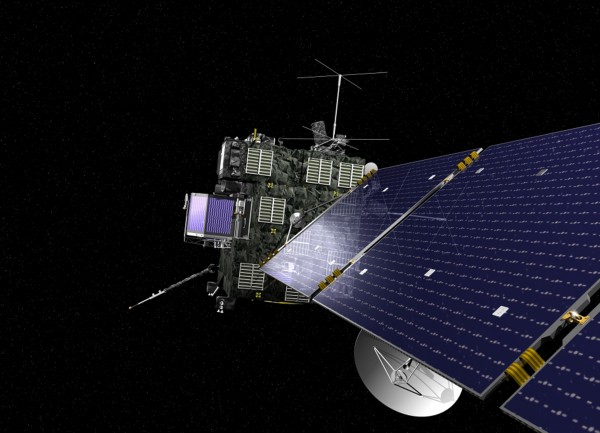Rosetta will be the First Spacecraft to Land on a Comet
| Ana Verayo | | Aug 03, 2014 05:12 AM EDT |
(Photo : Reuters) ESA's Rosetta spacecraft will now enter a comet's orbit and land on its surface this November.
A European space probe approaching its target comet in deep space has found the comet's surface is relatively warm and apparently holds a dark and dusty covering, mission controllers said.
The European Space Agency's Rosetta, an unmanned comet-hunting spacecraft, has taken the temperature of the comet "67P/Churyumov-Gerasimenko" after travelling 6 billion kilometers in a 10-year pursuit.
Like Us on Facebook
Rosetta is now ready to enter the comet's orbit. The robotic spacecraft will collect invaluable data about the physical properties and composition of the comet.
Rosetta will be the first spacecraft to land on any comet's surface.
Between July 13 and 21, Rosetta scanned the comet using an infrared spectrometer from a distance of 14,000 km to as close as 5,000 km.
As the spectrometer recorded the infrared light emanating from the comet, scientists estimated the comet's average temperature of around minus 94 Fahrenheit. This extreme cold is still relatively warmer by around 30 to 50 degrees as opposed to a comet entirely made out of ice, scientists say.
ESA confirms the comet's current temperature is direct evidence of the comet's dusty surface. This darker material easily heats up and emits more heat instantly than ice when it is exposed to sunlight.
The comet is currently 555 million kilometers away from the sun.
The US $1.9 billion Rosetta mission has spent the last 10 years shuttling from Earth and Mars where it used the planets' gravitational pull in a slingshot maneuver to gain more speed for the rendezvous.
Astrophysicists believe that comets are the keys to discovering the origins of the solar system that formed about 4.6 billion years ago.
Comets are also are relics left behind when the solar system was building itself .
On Aug. 6, Rosetta will approach the comet at its closest range ever at 100 km.
In November, Rosetta will drop a refrigertor-sized lab called Philae on the comet's surface, which will be the highlight of the mission.
With the mothership close by, Philae will be able to hold up for about six months on the surface as the comet passes around the sun and then towards the orbit of Jupiter by 2015.
The spacecraft is named after Rosetta, a famous ancient stone used to deciper Egyptian hieroglyphics now housed at the British Museum.
Philae is named after an obelisk that helped decipher the Rosetta stone.
TagsRosetta will be the First Spacecraft to Ever Land on a Comet, 67P/Churyumov-Gerasimenko, spacecraft lands on comet, comet near earth, comet near sun, will a comet hit earth, rosetta, philae, rosetta spacecraft, spacecraft comet mission
©2015 Chinatopix All rights reserved. Do not reproduce without permission
EDITOR'S PICKS
-

Did the Trump administration just announce plans for a trade war with ‘hostile’ China and Russia?
-

US Senate passes Taiwan travel bill slammed by China
-

As Yan Sihong’s family grieves, here are other Chinese students who went missing abroad. Some have never been found
-

Beijing blasts Western critics who ‘smear China’ with the term sharp power
-

China Envoy Seeks to Defuse Tensions With U.S. as a Trade War Brews
-

Singapore's Deputy PM Provides Bitcoin Vote of Confidence Amid China's Blanket Bans
-

China warns investors over risks in overseas virtual currency trading
-

Chinese government most trustworthy: survey
-

Kashima Antlers On Course For Back-To-Back Titles
MOST POPULAR
LATEST NEWS
Zhou Yongkang: China's Former Security Chief Sentenced to Life in Prison

China's former Chief of the Ministry of Public Security, Zhou Yongkang, has been given a life sentence after he was found guilty of abusing his office, bribery and deliberately ... Full Article
TRENDING STORY

China Pork Prices Expected to Stabilize As The Supplies Recover

Elephone P9000 Smartphone is now on Sale on Amazon India

There's a Big Chance Cliffhangers Won't Still Be Resolved When Grey's Anatomy Season 13 Returns

Supreme Court Ruled on Samsung vs Apple Dispute for Patent Infringement

Microsoft Surface Pro 5 Rumors and Release Date: What is the Latest?










